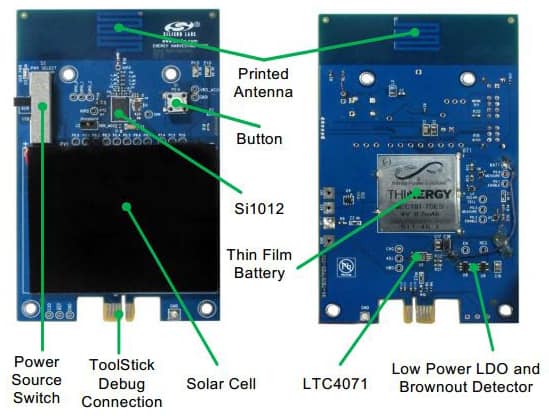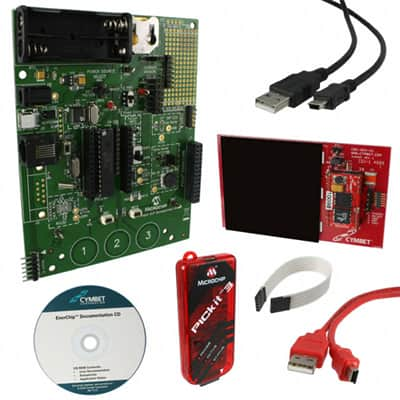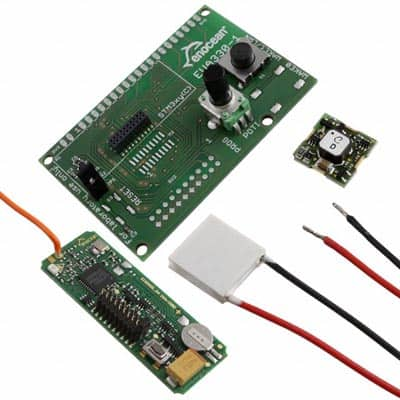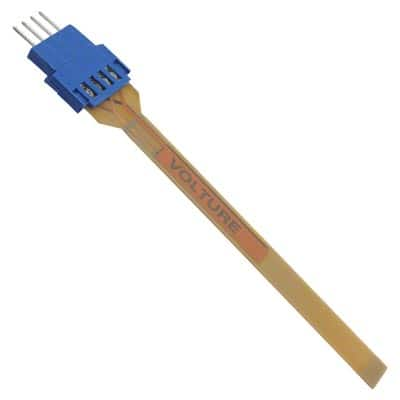Energy Harvesting for Industrial Networking
投稿人:DigiKey 欧洲编辑
2012-03-28
This article looks at the technologies and techniques for providing power to independent network nodes in an industrial environment, harvesting energy from vibration, solar, and thermal sources.
Energy management is an increasingly important part of any industrial operation. Electricity and gas are key overhead costs, and keeping these in check can be a constant challenge. At the same time more networked sensors can be used across the shop floor to monitor equipment with increasing energy demands. The market for such machine-2-machine (M2M) networked units is predicted to grow to over 50 billion devices over the next decade, and they all need power for operation.
While in an industrial environment, these M2M units often have an energy source nearby; it can be costly and time consuming to tie up a network node to a power socket. With improvements in chip manufacturing technology to dramatically bring the power consumption down, and a choice of frequencies and protocols that can provide long range with low power, these units can now take advantage of the local environment to generate their own power. This energy can come from a wide range of sources, from vibrational energy from moving equipment to thermal differences, and even from the energy from indoor lighting.
These are often used alongside a rechargeable battery that acts as a power source and a backup, but the key point is that these do not need replacing and can last the lifetime of the equipment as they are constantly recharged by the energy harvesting circuits. Such units are also self-contained so that they can be placed in areas that are hard to reach and where it would be difficult to replace the batteries, giving more flexibility to the operations manager to place these sensors and network nodes in exactly the optimum location.
Solar energy
The Silicon Labs Solar Energy Harvesting Board with Thin Film Battery (Figure 1) is an evaluation board that contains all the necessary elements to provide a networked node that is powered from indoor lighting or the sun. It is aimed at systems that wake periodically to measure and transmit results and, as it is powered from an energy harvesting source, the life expectancy of the thin film battery is greater than 15 years or 7000 mAh. This also means the wireless node can be designed with a very thin profile as the battery height is 0.17 mm to fit into the tightest spaces.

Figure 1: The details of the Silicon Labs Solar Energy Harvesting Board with Thin Film Battery.
The system consists of two components: a wireless sensor node and an EZRadioPRO USB dongle. The sensor node uses a Silicon Labs Si1012 wireless MCU. The dongle uses a Silicon Labs C8051F342 MCU and a Silicon Labs Si4431 radio operating at 919.84 MHz and is powered by a solar energy harvesting power supply. When the wireless sensor node is not transmitting data, the Si1012 wireless MCU can remain in a low-power state where it consumes only 50 nA. The leakage current of the energy harvesting supply, when enabled, is approximately 3 µA and is cancelled out by as little as 50 lux shining into the solar cell. This allows the energy harvesting supply to power the system for approximately seven days in a dark closet (in the ON position) or indefinitely if there is a periodic light source that replenishes the lost energy. The system works in both indoor lighting (200 lx) and outdoor lighting (10,000 lx) conditions.
The energy management circuitry used for harvesting energy consists of a solar cell that provides DC energy, a rectifier that can be used to convert AC vibration energy into DC energy, and a Linear Technologies battery management IC that takes in DC energy and regulates it to a constant 4.1 V. This also protects the battery from over discharge by disconnecting it from the circuit if its voltage gets too low and provides a “ship mode” that disconnects the battery during shipping and allows it to hold its energy until the end user starts up the system.
In an energy harvesting system, it is important to keep the energy used by the system lower than the amount of “harvested” energy in order to prevent a steady depletion of the stored energy. The larger the energy storage reservoir, the longer the system can go without “harvesting” new energy from the environment.
The energy storage used in this reference design is a 4.1 V, 700 µA-H thin film battery from IPS. This battery provides enough energy storage to keep the system running for many days without any “harvested” power.
The energy management circuitry at the output of the energy storage converts the 4.1 V thin film battery voltage to a regulated 2.7 V for use by the Si1012 Wireless MCU. The main components of this circuit are an ultra-low power LDO, a brownout detector, and a 100 µF tantalum capacitor to supply the peak currents required for RF transmission. The LDO’s shutdown pin is tied to the output of the brownout detector, so that the system is not powered until the 100 µF capacitor is charged up to at least 3.0 V. This ensures that the system will not attempt to power up unless it has enough stored energy to get it through the power up sequence.
Microchip’s XLP 16 bit Energy Harvesting Development Kit (Figure 2) also uses solar energy as the basis of a modular development platform for industrial energy harvesting applications. It is based on Microchip’s PIC MCUs with nanoWatt XLP Technology that provides sleep currents below 20 nA and brown-out reset down to 50 nA so that the system can run effectively from the small amounts of power available from the solar cell. It is aimed at RF sensors, temperature and environmental sensors, utility meters, and security sensors.

Figure 2: The Microchip XLP 16 bit Energy Harvesting Development Kit.
The development board portion of the kit features onboard temperature sensors, data EEPROM, a potentiometer, a watch crystal, LEDs, and an expansion connector for PICtail modules. These modules provide support for an RF transceiver and SD/MMC Cards.
The power for the kit is supplied by Cymbet’s Solar Energy Harvester. The harvester features a high-efficiency solar panel suitable for use with indoor or outdoor light that captures, manages and stores energy in two Cymbet EnerChip thin-film rechargeable energy storage devices. The EnerChips supply energy to the XLP development board when light is not available.
The power condition and capacity are monitored by the PIC24F microcontroller using Energy Conscious software algorithms developed by Microchip and Cymbet. The monitored information can be reported to the PC user interface via a USB connection. This allows for experimentation and balancing of energy collection vs. energy use, maximizing the benefits of the harvested energy for industrial networking.
Thermal energy
To convert power from the thermal energy in the environment, EnOcean’s EDK312 development kit (Figure 3) contains a low power RF transmitter module coupled with a Peltier-effect sensor to capture the heat energy.

Figure 3: The EnOcean EDK312 thermal energy harvesting development kit.
The STM 312 RF module operates at 868 MHz and supports a wide range of wireless and thermo-powered sensors such as temperature sensors, humidity sensors, or room operating panels and others.
The operation of the ECT310 DC/DC converter starts at 20 mV relating to a 2 Kelvin temperature difference from the low-cost standard Peltier element that is used as a thermo-electrical generator. A temperature difference between the two plates of a Peltier element generates electrical power and an ultra-low voltage DC/DC converter is required to boost the small output voltages to a voltage greater than 3 V as required for standard electronic circuits.
The efficiency of the energy generation depends on the thermal transfer resistance between the hot and cold sides of the Peltier element, so it is necessary to ensure good thermal insulation of the two ceramic wafers, for instance by using suitable plastic or styrofoam.
The kit comes with a pre-defined feature set for energy management, data acquisition, data processing, and wireless data transmission. Additionally, user specific applications can be implemented based on the Dolphin application programming interface (Dolphin API).
Vibrational Energy
In industrial environments there are also opportunities to use vibrational energy to power a network node. One way to do that is to use a piezoelectric sensor such as the Midé Volture V22 vibration energy harvester (Figure 4). This converts otherwise wasted energy from mechanical vibrations from motors or other equipment into useable electrical energy via Midé's patented piezoelectric transducer packaging technology.

Figure 4: The Mide V22 piezoelectric transducer for harvesting vibrational energy.
Through a proprietary manufacturing process, the Volture packages piezoelectric materials in a protective skin with pre-attached electrical leads, producing a robust component with no soldered wires. The protective skin also provides electrical insulation and defense against humidity and harsh contaminants that can be found in industrial environments.
The harvester can be tuned to the resonant frequency of a particular piece of equipment by adding small weights to the cantilever sensor, and this provides the optimum power output. It is often difficult to make use of low-voltage energy scavenging sources, such as piezo energy harvesters at low vibration amplitudes because most RF chips need minimum voltages of 1.8 V or greater to operate.
Using these sources requires a voltage boost converter with a minimum start-up voltage, low start-up current requirement, and graceful handling of undervoltage and slow input voltage rise times. This can be provided by a charge pump chip that provides bursts of power starting at approximately 2.4 VDC (ending at 1.6-2 VDC) from input voltages as low as approximately 380 mV. This provides boosting using small on-chip switched (“flying”) capacitors, rather than inductive boost conversion. This means the initial input current requirements are reduced compared to a typical boost converter, requiring only a small power-supply bypass capacitance to reliably start up. This is ideal for directly powering small sensors that can perform their function such as recording and transmitting a measurement in a known amount of time and power.
There is a wide range of sources of power from energy harvesting, and each industrial environment is going to have its own requirements. Using vibrational energy from motors to power the sensors that determine the health of the motor makes a lot of sense, especially when the sensors can be attached with a wireless network node without power leads by using energy harvesting. This allows the node to be buried deep inside a machine, providing vital data on the health of the system without the added costs of replacing batteries.
Using solar energy and even temperature differences to power the wireless networks provides flexibility in monitoring and controlling industrial equipment and allowing costs to be controlled more tightly. Detailed development kits that bring together the energy harvesting transducers, microcontrollers, radio transceivers, and rechargeable batteries help the equipment developer and the network designer to experiment with the most effective ways to harvest the local energy to power the network.

免责声明:各个作者和/或论坛参与者在本网站发表的观点、看法和意见不代表 DigiKey 的观点、看法和意见,也不代表 DigiKey 官方政策。




